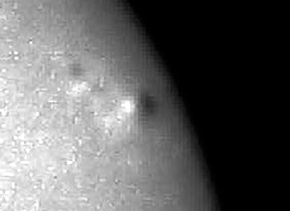

Researchers involved in a FAPESP-funded study conducted at the Mackenzie Center of Radioastronomy and Astrophysics announced the detection in an article published in The Astrophysical Journal
Brazilian researchers announced the detection in an article published in The Astrophysical Journal.
Brazilian researchers announced the detection in an article published in The Astrophysical Journal.

Researchers involved in a FAPESP-funded study conducted at the Mackenzie Center of Radioastronomy and Astrophysics announced the detection in an article published in The Astrophysical Journal
By José Tadeu Arantes
Agência FAPESP – An intense solar burst was detected for the first time at frequencies ranging from the mid- to far-infrared. The discovery was published in the online edition of The Astrophysical Journal on April 24, 2013, and will be included in the printed version slated for publication on May 10, 2013.
The phenomenon, observed at a frequency of 30 terahertz (THz), in the band of the electromagnetic spectrum located between radio waves and visible light, was detected using a new system operating at the El Leoncito Observatory in the Argentine Andes on March 13, 2012. The discovery was kept secret until its announcement in the prestigious scientific periodical.
The study is part of the Thematic Project “Solar Activity Emissions from Submillimeter Waves to Infrared (SIRA)” that was funded by FAPESP and led by the Mackenzie Center of Radioastronomy and Astrophysics (CRAAM), Universidade Presbiteriana Mackenzie, in collaboration with the Semiconductor Components Center at Universidade Estadual de Campinas (Unicamp), the El Leoncito Astronomical Complex in Argentina and the Bernard Lyot Solar Observatory in Campinas.
“The range of terahertz frequencies is the last unexplored frontier in the study of solar bursts. And this discovery, absolutely unexpected and surprising, could inaugurate a new phase of research on the sun,” said the project’s coordinator Pierre Kaufmann of CRAAM.
Kaufmann has been intensively dedicated to the study of terahertz solar emissions, particularly with the Solar-T experiment, led by him and funded by FAPESP under the auspices of the same Thematic Project. However, though the Solar-T equipment, which will be sent on long-duration flights aboard stratospheric balloons, is destined to monitor solar flares in the 3 THz to 7 Hz range, the burst in question occurred at a frequency 10 times higher in a “window” with little absorption. Thus, the burst could be observed from the ground at El Leoncito, despite the thick barrier that the Earth’s atmosphere poses to terahertz radiation.
“The intense shine detected in the infrared presented a notable coincidence in space and time with other emissions observed from the ground or by satellites in radio, white light, ultraviolet and hard X-rays,” said Kaufmann. The conclusion is that all of these radiation events were provoked by the same highly energetic phenomenon.
“Our main hypothesis is that these emissions result in the acceleration of high-energy particles in the magnetic fields of sun spots. But besides the particle acceleration mechanism still being ignored, we also don’t know in what region of the sun it occurs, if it’s on the solar surface or the atmosphere,” he said.
Sun spots
The current models on the structure of the sun generally recognize four major regions: the nucleus, where the thermonuclear reactions that are responsible for solar energy occur; the convective zone, the area where gigantic convection movements transport the energy of the nucleus to the surface; the surface or photosphere; and the atmosphere, which consists of a fine transition layer, known as the chromosphere, and the corona, which extends into space. The atmosphere is composed of plasma, very hot ionized gas, permeated by magnetic fields originating from sunspots.
The explosions that occur in these magnetized plasma structures are supposedly phenomena that originate on the surface or above it in the chromosphere and corona. However, the cause of these explosions is still unknown, and their interpretation constitutes one of the greatest challenges of contemporary physics.
“Although the diverse and spectacular manifestations of the explosions are well described and explained, with emissions that range from radio to gamma waves, the physical processes that they originate from remain a mystery,” commented Kaufmann.
The FAPESP-funded Thematic Project that Kaufmann coordinates receives complementary subsidies from CNPq, Mackpesquisa, Conicet in Argentina, the U.S. Air Force Research Laboratory and NASA. The project is precisely directed toward understanding these explosive processes, and the recent discovery could represent an important step in this regard because it opens a new “window” over frequencies near 30 THz to obtaining landmark data.
The article “A bright impulsive solar burst detected at 30 THz” (doi:10.1088/0004-637X/768/2/134) can be read at http://iopscience.iop.org/0004-637X/768/2/134.
Republish
The Agency FAPESP licenses news via Creative Commons (CC-BY-NC-ND) so that they can be republished free of charge and in a simple way by other digital or printed vehicles. Agência FAPESP must be credited as the source of the content being republished and the name of the reporter (if any) must be attributed. Using the HMTL button below allows compliance with these rules, detailed in Digital Republishing Policy FAPESP.





